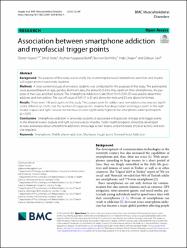| dc.contributor.author | Yasarer, Ozden | |
| dc.contributor.author | Mete, Emel | |
| dc.contributor.author | Benli, Reyhan Kaygusuz | |
| dc.contributor.author | Kilic, Berivan Beril | |
| dc.contributor.author | Dogan, Halis | |
| dc.contributor.author | Sari, Zubeyir | |
| dc.date.accessioned | 2024-05-03T07:12:27Z | |
| dc.date.available | 2024-05-03T07:12:27Z | |
| dc.date.issued | 2024 | en_US |
| dc.identifier.citation | Yaşarer, Ö., Mete, E., Kaygusuz Benli, R., Kılıç, B. B., Doğan, H., & Sarı, Z. (2024). Association between smartphone addiction and myofascial trigger points. BMC Musculoskeletal Disorders, 25(1), 254. | en_US |
| dc.identifier.issn | 14712474 | |
| dc.identifier.uri | https://doi.org/10.1186/s12891-024-07383-4 | |
| dc.identifier.uri | https://hdl.handle.net/20.500.12294/4089 | |
| dc.description.abstract | Background The purpose of this study was to clarify the relationship between smartphone addiction and miyafascial trigger points in university students. Methods A cross-sectional study of university students was conducted for the purpose of this study. The participants were assessed based on age, gender, dominant side, the amount of time they spent on their smartphones, the purpose of their use, and their posture. The Smartphone Addiction Scale Short Form (SAS-SF) was used to determine addictes and non-addicts. The cut-off value of SAS-SF is 31 and above for male and 33 and above for female. Results There were 136 participants in the study. The posture score for addicts and non-addicts ones was not significantly different (p > 0,05), but the number of trigger points, maximal bending posture and trigger points in the right levator scapula and right cervical erector muscles were significantly higher in the smartphone addict participants (p < 0,05). Conclusions Smartphone addiction in university students is associated with postural changes and trigger points in the bilateral levator scapula and right cervical erector muscles. Public health programs should be developed to raise awareness about smartphone addiction, encourage screen breaks, and emphasize physical activity and exercise regularly. | en_US |
| dc.language.iso | eng | en_US |
| dc.publisher | BioMed Central Ltd | en_US |
| dc.relation.ispartof | BMC MUSCULOSKELETAL DISORDERS | en_US |
| dc.identifier.doi | 10.1186/s12891-024-07383-4 | en_US |
| dc.rights | info:eu-repo/semantics/openAccess | en_US |
| dc.subject | INTERRATER RELIABILITY | en_US |
| dc.subject | MUSCULOSKELETAL PAIN | en_US |
| dc.subject | POSTURE | en_US |
| dc.subject | STUDENTS | en_US |
| dc.subject | SENSITIVITY | en_US |
| dc.title | Association between smartphone addiction and myofascial trigger points | en_US |
| dc.type | article | en_US |
| dc.department | Sağlık Bilimleri Yüksekokulu, Fizyoterapi ve Rehabilitasyon Bölümü | en_US |
| dc.authorid | 0000-0001-7376-3007 | en_US |
| dc.authorid | 0000-0002-6055-2523 | en_US |
| dc.identifier.volume | 25 | en_US |
| dc.identifier.issue | 1 | en_US |
| dc.relation.publicationcategory | Makale - Uluslararası Hakemli Dergi - Kurum Öğretim Elemanı | en_US |
| dc.institutionauthor | Yasarer, Ozden | |
| dc.institutionauthor | Dogan, Halis | |
| dc.authorwosid | A-3051-2019 | en_US |
| dc.authorwosid | AAT-4500-2021 | en_US |
| dc.authorscopusid | 58037348900 | en_US |
| dc.authorscopusid | 58243460700 | en_US |
| dc.identifier.wosquality | Q2 | en_US |
| dc.identifier.wos | WOS:001195650000006 | en_US |
| dc.identifier.scopus | 2-s2.0-85189067635 | en_US |
| dc.identifier.pmid | 38561699 | en_US |


















